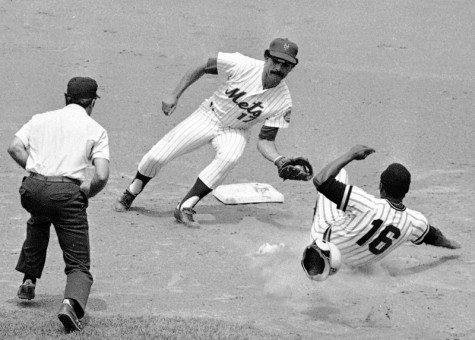
I was on vacation in Japan when the Mets acquired Felix Millan in the winter of 1972.
I found out about the trade – Millan and lefty pitcher George Stone from the Atlanta Braves for starting pitcher Gary Gentry and reliever Danny Frisella – via a tiny mention of it in the International Edition of the New York Times.
1972 had been a very disappointing, injury-filled season for the Mets. Prior to the season, the Mets had acquired perennial All-Stars Jim Fregosi and Rusty Staub. Adding them to the lineup to go along with the best pitching in baseball figured to make the Mets a strong favorite for another championship.
Unfortunately, by the time the season ended, the pitching was intact, but the lineup was in shambles. In addition to the injuries, regular second baseman Ken Boswell finished the season batting .211, bad any way you look at it, but especially for a second baseman whose bat was considered his best asset. So the Mets looked for a replacement.
Millan was a former all-star coming off his worst season, but undoubtedly a better second baseman than Boswell. Gentry was, at 26, still young enough to become a star, although he was no better than a third starter with the Mets. Stone was a fringe major leaguer and Frisella a good reliever who was behind Tug McGraw in the Mets’ bullpen hierarchy.
At the time, the deal didn’t look all that good to me, because Millan at best was “steady” and Stone looked like he’d struggle to make the Mets, while the two pitchers the Mets gave up were young enough and good enough to have long, productive careers. But it turned out to be a steal for the Mets.
In seven seasons with the Braves, Millan batted .281 with a .668 OPS and a cumulative 9.4 WAR in 799 games. In that era, and long before the steroids era, those numbers ranged between very good and All Star level for a second baseman.
 After joining the Mets, “The Cat” as he was known, continued to produce at that level but also became very accomplished in another distinguishing aspect of his game. The three-time All Star batted .279 with a .663 OPS and 8.1 WAR in 4 1/2 seasons with the Amazins.
After joining the Mets, “The Cat” as he was known, continued to produce at that level but also became very accomplished in another distinguishing aspect of his game. The three-time All Star batted .279 with a .663 OPS and 8.1 WAR in 4 1/2 seasons with the Amazins.
Millan also became MLB’s toughest player to strikeout and was always putting the ball in play and making things happen. For five consecutive seasons, one with the Braves and four with the Mets, he led the league in At-Bat to Strikeout ratio.
In fact, during his tenure with the Mets he finished with a remarkable 3.1% strikeout rate – the best mark in the majors during that span. To put that into raw numbers, that’s 92 strikeouts in 2,954 plate appearances.
With his trademark style of choking up on the bat, Milan was a catalyst for the Mets at the top of the order, batting second and hitting .291 while scoring 82 runs during the team’s incredible 1973 season. Unfortunately, the Mets ended up losing the World Series to the Oakland A’s in seven games.
A Puerto Rican native, Millan gave the Mets four very solid seasons before he was forced to retire in 1977 because of a serious shoulder injury he sustained in a brawl with Pirates catcher Ed Ott.
After Ott slid hard into Millan to break up a double play, the smallish second baseman punched Ott in the face with his fist clenched around the baseball. Ott responded by lifting Millan off his feet and then slamming him hard onto the ground. He did attempt to resurrect his career playing in Japan, but that was the last MLB game Millan would ever play.
George Stone was remarkable for the 1973 Mets, finishing 12-3 with a 2.80 ERA in 148 innings. After ’73, Stone did little to help the Mets and was gone after two more mediocre seasons. But clearly, this trade put the Mets in the 1973 World Series as much as anything.
As for Gentry and Frisella, elbow problems plagued Gentry for the rest of his career and he never really helped the Braves. He got one last spring training shot with the Mets a few years later, but was quickly released. Frisella was a mediocre reliever the rest of his career before his untimely passing in a dune-buggy accident before the 1977 season.
Did You Know?
On July 21, 1975, Joe Torre set an MLB record by grounding into four double-plays in a single game. Felix Millan had a nice 4-for-4 day at the plate singling all four times while batting ahead of Joe Torre in that game.
Afterward, Torre went into the clubhouse turned to the reporters at his locker and famously said, “I’d like to thank Felix Millan for making all of this possible.”
Millan jokingly responded, “Geesh, you’d think that big oaf would at least hit a two-run homer or something.”














